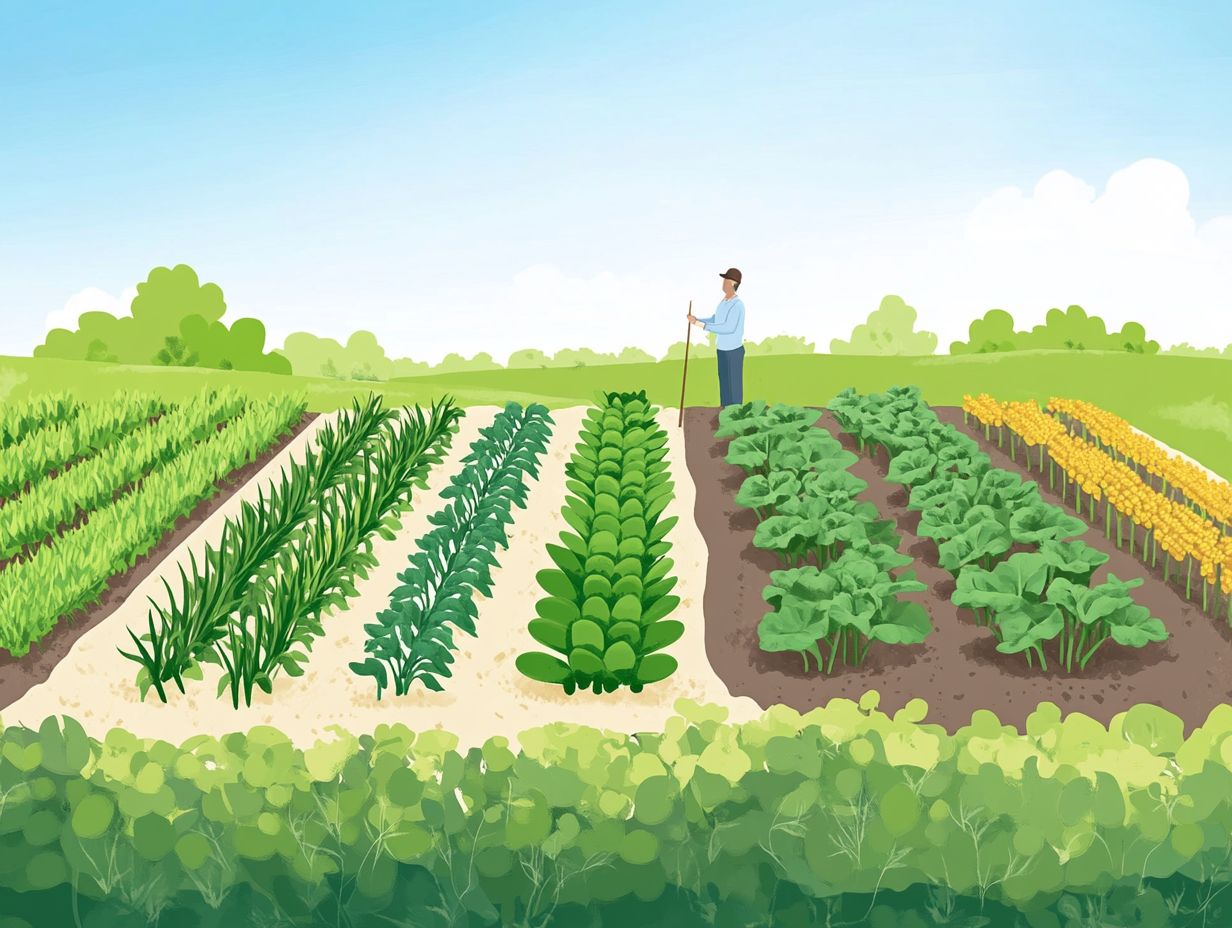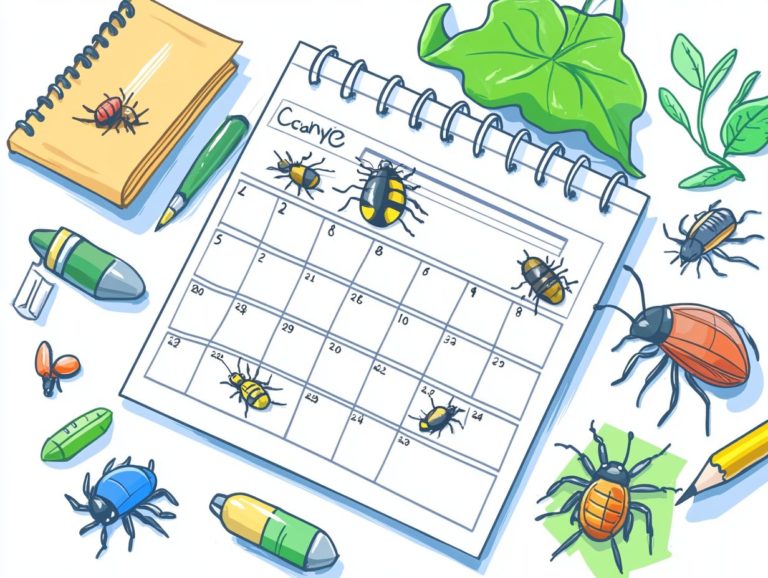The Benefits of Crop Rotation for Pest Control
Crop rotation is a time-honored agricultural practice that enhances soil health and plays a vital role in pest management.
By varying the types of crops cultivated, you disrupt pest life cycles and minimize infestations. This results in healthier plants and improved yields.
This article explores the definition and purpose of crop rotation, its effectiveness in pest control, the benefits it offers, and practical tips for implementation.
Adopting this sustainable practice can elevate your farming methods to new heights.
Contents
- Key Takeaways:
- Understanding Crop Rotation
- The Role of Crop Rotation in Pest Control
- Benefits of Crop Rotation for Pest Control
- Implementing Crop Rotation in Your Farming Practices
- Potential Challenges and Solutions
- Frequently Asked Questions
- What is crop rotation and how does it benefit pest control?
- How does crop rotation reduce pest populations?
- Does crop rotation work for all types of pests?
- What are the additional benefits of crop rotation for pest control?
- Are there any downsides to crop rotation for pest control?
- Are there alternative methods to crop rotation for pest control?
Key Takeaways:

- Crop rotation involves planting different crops in a specific order to benefit the soil and control pests.
- This effective and natural method disrupts pest life cycles, reducing their numbers without pesticides.
- Implementing crop rotation leads to improved soil health and increased crop yields.
Understanding Crop Rotation
Crop rotation involves alternating the types of crops grown on land over time. This method enhances soil health, boosts crop diversity, and combats soilborne diseases.
It optimizes nutrient usage while disrupting pest life cycles. This helps manage insect populations sustainably.
Farmers can cultivate diverse plant families, creating a resilient agricultural ecosystem, especially in regions like Massachusetts and Connecticut.
Definition and Purpose
The concept of crop rotation includes alternating different crops on the same land across seasons. This enhances soil health, increases crop diversity, and promotes agricultural sustainability.
By using this technique, you can boost nutrient levels in your soil, maintaining fertility over time. For example, growing legumes, which add nitrogen, in succession with corn reduces reliance on synthetic fertilizers.
Rotating crops disrupts pest life cycles and decreases disease outbreaks that flourish from continuous planting of the same crop. A common sequence might involve planting wheat, followed by soybeans, and then corn.
The Role of Crop Rotation in Pest Control
Crop rotation is essential for effective pest control, disrupting pests like the Western corn rootworm. This approach reduces pest populations and lessens reliance on chemical pesticides.
By alternating crops, you attract beneficial insects that naturally manage pest populations. This method is effective at different stages of pest life cycles.
Start implementing crop rotation today and watch your farm thrive!
How it Works to Reduce Pests
Crop rotation is a smart way to minimize pest populations. By introducing diverse crops, you disrupt the life cycles of certain pests and reduce their food sources.
This approach makes the environment less appealing to pests and boosts the number of beneficial insects that help control them.
For example, rotating legumes with high-nitrogen plants can prevent aphid infestations, as these pests thrive on consistent plants. Changing the planting of brassicas can limit the lifespan of pests like the cabbage worm, which gets confused without its preferred food.
By promoting crop diversity, you create a balanced ecosystem that attracts natural predators. This helps manage pest populations effectively through the simple practice of crop rotation.
Benefits of Crop Rotation for Pest Control

Implementing crop rotation offers numerous benefits for pest control. It enhances healthy soil, reduces reliance on pesticides, and boosts your crop yields.
By improving soil fertility and structure, crop rotation fights soilborne diseases. This practice is essential for strong crop production and helps create resilient harvests.
Improved Soil Health
Improved soil health is a major benefit of crop rotation. This practice balances nutrients and boosts microbial activity, creating a fertile environment.
Incorporating beneficial crops like legumes helps fix nitrogen and restore soil fertility. The result is healthier plants and stronger agricultural systems.
Diversifying crops in your rotation prevents nutrient depletion and builds a dynamic soil ecosystem. Adding deep-rooted crops like carrots or turnips helps break up compacted soil layers.
This promotes better water infiltration and root growth, allowing your crops to thrive. Rotating grains, vegetables, and cover crops protects precious topsoil and reduces soil erosion.
Reduced Reliance on Pesticides
Crop rotation significantly reduces your need for chemical pesticides. This method disrupts the life cycles of pests like the northern corn rootworm and black cutworm.
This approach not only fosters healthier ecosystems but also aligns with organic farming principles focused on sustainable pest management.
Research shows that farms using crop rotation can cut pesticide use by up to 50%. This benefits both the environment and crop productivity.
Alternating crops creates an environment where beneficial insects thrive while pests struggle. This diversity enriches the ecosystem, improving soil health and crop resilience.
Studies also show that these practices can reduce soil erosion and runoff, protecting water quality. By integrating crop variation, you lessen the need for synthetic chemicals and support overall agricultural sustainability.
Increased Crop Yields
Increased crop yields are a remarkable benefit of adopting crop rotation. This practice elevates crop diversity and optimizes nutrient uptake, leading to healthier plants and bountiful harvests. You can experience enhanced productivity and profitability by strategically rotating your crops based on their nutrient needs and pest resistance traits.
For example, combining legumes with cereals can significantly boost soil nitrogen levels. This results in impressive yield increases for crops like corn and wheat sometimes by as much as 20%. Crop rotation also reduces the prevalence of pests and diseases, minimizing your reliance on chemical interventions.
This practice boosts soil health and is a game-changer for your farm! It prevents erosion and conserves moisture while nurturing a balanced ecosystem that attracts beneficial organisms.
By thoughtfully managing your crop rotations, you can achieve long-term sustainability, proving that ecological practices can translate into substantial economic benefits. Start planning your crop rotation today for a healthier, more profitable farm!
Implementing Crop Rotation in Your Farming Practices
Implementing crop rotation in your farming practices requires a clear plan that considers crop diversity, soil health, and effective pest management strategies. These elements are vital for long-term sustainability in agriculture.
You can enhance your farming outcomes by adopting best practices that optimize planting times and crop selection. This will ultimately create a resilient system capable of thriving even in challenging conditions.
By nurturing ecological balance, these practices improve your yields and contribute to healthier ecosystems overall.
Best Practices and Tips

Implementing best practices for crop rotation requires thoughtful planning, embracing crop diversity, and mastering pest management. These elements can yield remarkable benefits, particularly in organic farming systems.
As you develop your rotation schedules, consider factors such as crop families, soil types, and the unique requirements of your crops. Timing is everything in successful crop rotation; it s vital to plant and harvest at just the right moments to optimize yield and enhance soil health.
By selecting a variety of crops from different families, you can boost soil fertility. Some plants enrich the soil with essential nutrients while others might extract them.
Crafting a sensible rotation sequence such as alternating plants that require a lot of nutrients with soil-restoring legumes can help maintain ecological balance. Regularly monitoring soil health throughout each cycle allows for timely adjustments. Keeping an eye on pest populations can unveil patterns that inform your future crop choices, enabling you to take proactive measures.
Potential Challenges and Solutions
While crop rotation presents numerous benefits, you might face some challenges along the way. These can include pest pressures, soil health concerns, and the necessity for a deep understanding of crop compatibility.
Act swiftly to address these challenges with strategic planning and targeted solutions. This approach allows you to maximize the advantages of crop rotation while effectively minimizing any setbacks.
Dealing with Potential Setbacks
Navigating potential setbacks in crop rotation demands proactive strategies and a comprehensive understanding of pest control and soil management techniques. These elements are crucial for mitigating the risks inherent in agricultural practices.
Pest infestations can jeopardize both crop yields and quality. Unpredictable weather can introduce challenges that disrupt your carefully planned cycles. To effectively address these hurdles, it’s essential to adopt a mix of natural pest control methods and careful pesticide use. This approach combines using natural predators to manage pests, cultural methods, and judicious pesticide application when necessary.
Keeping open lines of communication with local agricultural extension services is invaluable. They provide vital insights into prevailing weather patterns and pest behaviors that affect your crops. Embracing flexibility in crop selection enables you to adapt as conditions evolve, ensuring that your practices remain sustainable.
Committing to ongoing education about emerging agricultural technologies and methodologies equips you to respond confidently to challenges, safeguarding your productivity and livelihood.
Frequently Asked Questions
What is crop rotation and how does it benefit pest control?
Crop rotation is the practice of growing different crops in the same field in a planned sequence. This helps break the pest cycle, making it difficult for pests to establish and spread throughout the crop. It also improves soil health, making crops more resilient to pests.
How does crop rotation reduce pest populations?
Crop rotation disrupts the habitat and food sources of pests, making it difficult for them to survive and reproduce. By changing the types of crops grown, certain pests can be starved out, significantly reducing their numbers.
Does crop rotation work for all types of pests?
Crop rotation is effective for many types of pests, including insects, weeds, and diseases. However, some pests may be more resilient and adapt to different crop types. Make sure to research and customize your crop rotations to target local pests effectively!
What are the additional benefits of crop rotation for pest control?
Aside from reducing pest populations, crop rotation also helps improve soil health and fertility, which is crucial for the importance of soil health in pest control. This leads to healthier and more resilient plants, reducing the need for chemical pesticides. It also promotes biodiversity, creating a more balanced ecosystem that can naturally control pest populations.
Are there any downsides to crop rotation for pest control?
While crop rotation is generally beneficial, it can be time-consuming and labor-intensive. It requires careful planning and management, as well as rotating crops on a regular basis. It may also be challenging for larger farms with extensive land.
Are there alternative methods to crop rotation for pest control?
Yes, there are other methods that can be used alongside crop rotation for effective pest control. These include intercropping, the use of trap crops, and utilizing natural predators or biological control methods. It is important to assess specific pest issues and determine the best combination of methods for your crops.
Start your crop rotation plan today to boost your yields!







